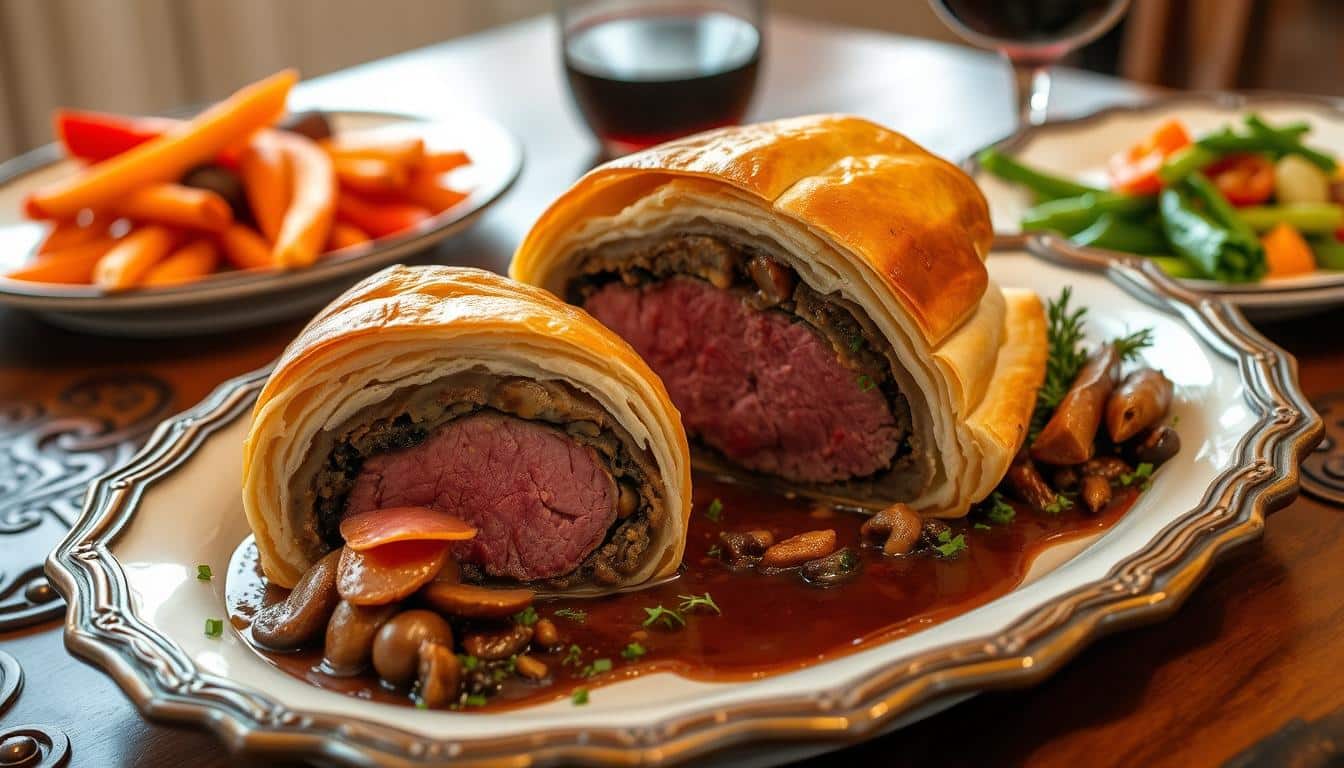Beef Wellington is a dish that mixes tender filet mignon with rich mushroom duxelles. It’s all wrapped in golden puff pastry. This dish is loved by many and praised by famous chefs like Gordon Ramsay.
In this guide, we’ll show you how to make Beef Wellington at home. You’ll learn to pick the best ingredients and master key techniques. Soon, you’ll impress your guests with this amazing dish.
Are you ready to improve your cooking? Let’s start making the perfect Beef Wellington together!
Understanding the Legacy of Beef Wellington
Beef Wellington has a long history. It started as a simple dish and grew into a symbol of fine dining. Let’s look at its beginnings, how it’s changed, and why it’s loved by many.
Origins and Historical Significance
The start of Beef Wellington is a mystery, but it’s thought to be from the early 1800s. It was named after the Duke of Wellington. This dish was a hit with the British aristocracy because of its tender beef, mushrooms, and flaky pastry.For tips on perfecting classic dishes, explore our Original Toll House Cookie Recipe.
Gordon Ramsay’s Modern Interpretation
Gordon Ramsay made Beef Wellington famous. His version uses beef tenderloin, prosciutto, and mushroom duxelles. Ramsay’s method focuses on precision, making the dish even better.
Why This Dish Earned Michelin Star Status
Beef Wellington’s Michelin star shows its complexity and skill needed to make it. It’s all about perfect flavors and textures. Being on Michelin menus shows its historical value and a chef’s skill.
| Aspect | Traditional Beef Wellington | Gordon Ramsay’s Version |
|---|---|---|
| Beef Cut | Tenderloin | Center-cut Filet Mignon |
| Wrapper | Puff Pastry | Puff Pastry with Prosciutto |
| Mushroom Layer | Basic Duxelles | Enhanced Duxelles with Herbs |
| Cooking Technique | Oven-baked | Seared then Oven-finished |
Essential Ingredients for an Authentic Beef Wellington
To make a perfect Beef Wellington, you need to pick the right ingredients. We’ll show you how to choose the best parts for this classic dish. This will make sure your dish is delicious and will wow your guests.For another hearty beef recipe, check out our Tender Beef Tips Recipe.
Selecting the Perfect Beef Tenderloin
The beef tenderloin is the main part of Beef Wellington. Look for a cut that’s well-marbled and bright red. A 2-3 pound center-cut tenderloin is best for even cooking. Ask your butcher to remove excess fat and silver skin for you.
Choosing Quality Puff Pastry
Homemade puff pastry is great, but store-bought can be just as good. Choose all-butter puff pastry for the best taste and texture. Let it thaw in the fridge overnight to avoid sogginess.
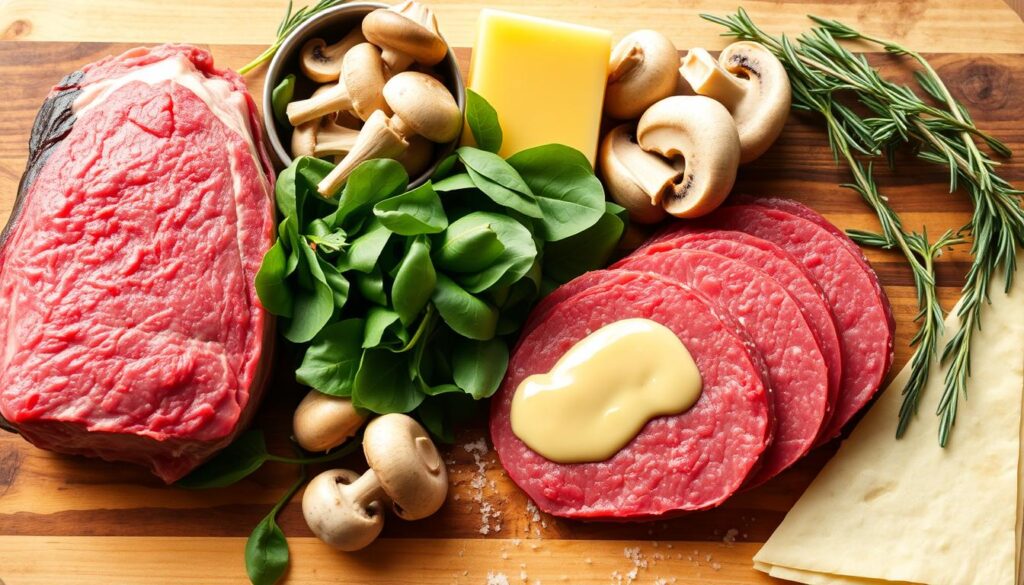
Mushroom Duxelles Components
Mushroom duxelles adds a rich flavor to Beef Wellington. Use wild mushrooms like shiitake, cremini, and porcini for a deep taste. Chop them finely and cook with shallots, garlic, and herbs until they’re like a paste.
Prosciutto and Additional Ingredients
Prosciutto keeps the beef and pastry from getting soggy. Pick thinly sliced, high-quality prosciutto. You’ll also need Dijon mustard, fresh thyme, and egg wash for the pastry. For a different twist, try our tender beef tips recipe as a main dish.
| Ingredient | Quantity | Notes |
|---|---|---|
| Beef Tenderloin | 2-3 pounds | Center-cut, trimmed |
| Puff Pastry | 1 sheet | All-butter, thawed |
| Mushrooms | 1 pound | Mixed varieties |
| Prosciutto | 6-8 slices | Thinly sliced |
Preparing Your Beef Tenderloin
The first step in making a perfect Beef Wellington is to prepare the beef tenderloin. This cut, also known as filet mignon, needs careful handling. This ensures the best flavor and texture.
Begin by trimming off any extra fat or silver skin from the beef tenderloin. This makes the shape even and removes tough parts. Then, pat the meat dry with paper towels. This helps get a better sear.
Season the beef tenderloin well with salt and black pepper. For extra taste, rub it with herbs like thyme or rosemary. Let the seasoned beef sit at room temperature for about 30 minutes before cooking.
To get a perfect crust and keep the inside tender, sear the beef tenderloin in a hot skillet. Heat a cast-iron pan over high heat and add a bit of oil. Sear the meat for 2-3 minutes on each side until it’s golden brown.
| Step | Action | Duration |
|---|---|---|
| 1 | Trim and pat dry | 5-10 minutes |
| 2 | Season | 2-3 minutes |
| 3 | Rest at room temperature | 30 minutes |
| 4 | Sear in hot skillet | 8-10 minutes |
After searing, let the beef tenderloin cool completely. Then, wrap it in mushroom duxelles and puff pastry. This cooling step is key to avoid overcooking during baking.
Mastering the Mushroom Duxelles
The heart of a perfect Beef Wellington is its mushroom duxelles. This filling makes the dish go from good to great. Let’s dive into making this key part.
Proper Mushroom Selection and Preparation
Choosing the right mushrooms is key for flavor. We like a mix of cremini and shiitake for their taste. Clean them gently with a damp cloth, but avoid water to keep them dry.
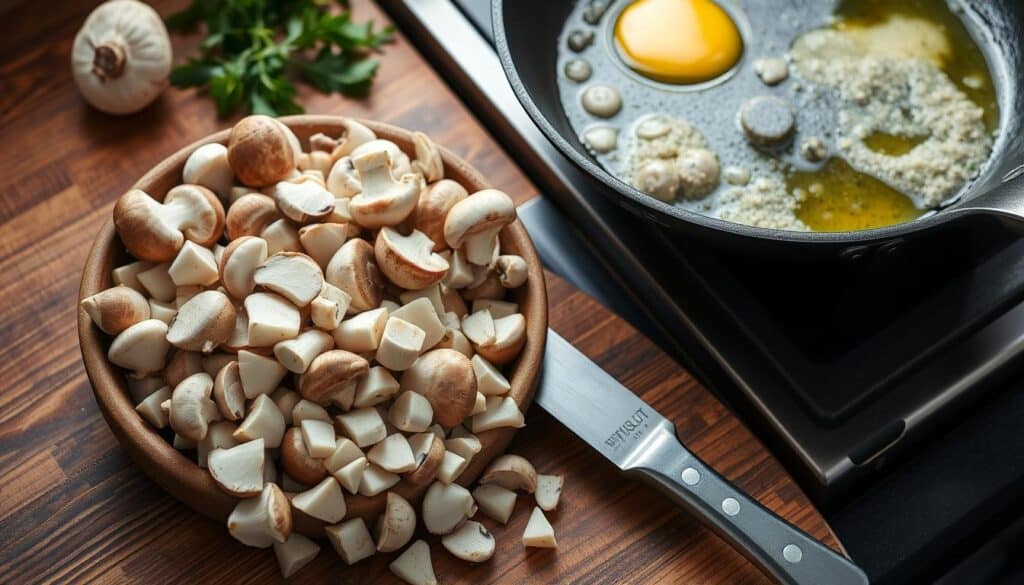
Cooking Techniques for Perfect Duxelles
To make the best mushroom duxelles, chop the mushrooms finely. Cook them slowly in butter with shallots and herbs. This method makes the flavors stronger and removes extra moisture, so the Wellington stays dry.
Achieving the Right Consistency
The duxelles should be like a paste, not too wet or dry. Cook it until it’s dark and all liquid is gone. This makes sure the duxelles won’t make the pastry soggy when it’s baked.
| Ingredient | Amount | Preparation |
|---|---|---|
| Mushrooms | 1 pound | Finely chopped |
| Shallots | 2 | Minced |
| Garlic | 2 cloves | Minced |
| Thyme | 1 sprig | Leaves only |
| Butter | 2 tablespoons | Unsalted |
Remember, making mushroom duxelles takes patience. The effort you put in here will make your Beef Wellington unforgettable.
The Art of Layering Your Wellington
Layering a Beef Wellington is a delicate process. It needs precision and care. We’ll show you how to make a dish that looks great and tastes amazing.
Start with a sheet of plastic wrap on your work surface. Lay out overlapping slices of prosciutto to cover your beef tenderloin. Spread cooled mushroom duxelles evenly over the prosciutto layer.
Place your seasoned and seared beef tenderloin in the center. Using the plastic wrap, tightly roll the prosciutto around the beef. Twist the ends to secure and refrigerate for 15 minutes.
Next, roll out your puff pastry on a lightly floured surface. Remove the plastic wrap from your beef. Place it in the center of the pastry.
Fold the pastry around the beef, sealing the edges with egg wash. Trim any excess pastry. Use it to create decorative patterns on top.
The key to a successful Beef Wellington is careful layering. This ensures flavors meld perfectly and the pastry crust stays crisp during baking.
| Layer | Ingredient | Purpose |
|---|---|---|
| 1 | Prosciutto | Protects pastry from moisture |
| 2 | Mushroom Duxelles | Adds flavor and texture |
| 3 | Beef Tenderloin | Main protein |
| 4 | Puff Pastry | Crispy outer shell |
Perfecting the Pastry Wrap Technique
Wrapping Beef Wellington in puff pastry is key. It needs finesse and detail. We’ll show you how to get a perfect pastry crust that looks great and tastes amazing.
Rolling and Sealing Methods
Begin by rolling out puff pastry on a floured surface. Make it about 1/8 inch thick. Place the pastry over your beef tenderloin. Cut off extra pastry, leaving enough to seal.
Press the edges together firmly. Fold them under to make a neat package.
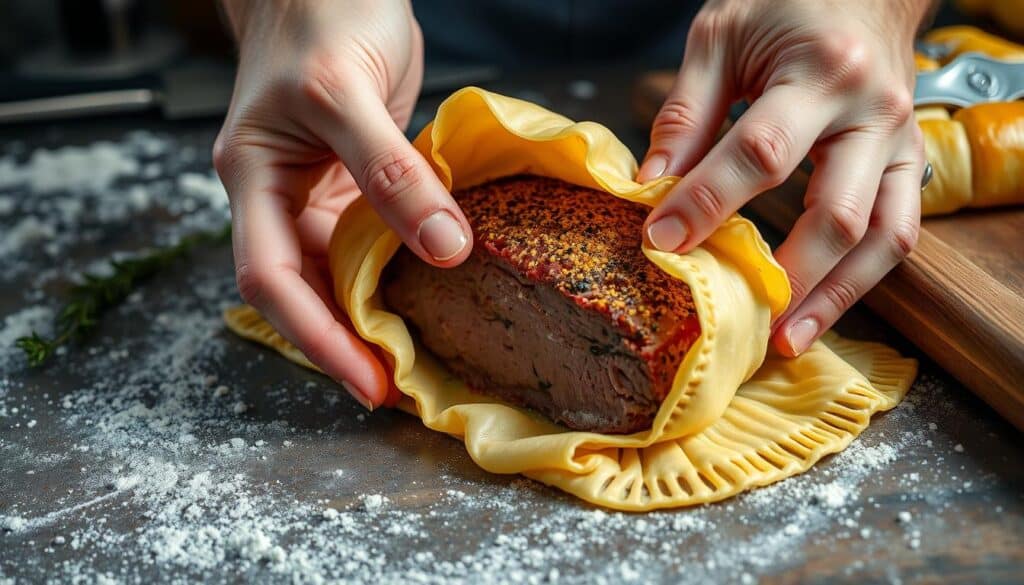
Creating Decorative Patterns
Make your Beef Wellington look better with designs. Use leftover pastry for leaves, lattice, or braids. Place these on top with a light egg wash.
Be creative but don’t overwork the pastry. This keeps it flaky.
Egg Wash Application Tips
For a golden finish, brush with egg wash. Mix one egg with a tablespoon of water or milk. Use a pastry brush to apply it evenly.
This ensures a uniform color and shine after baking.
Getting a perfect Beef Wellington is all about the pastry wrap details. With practice, you’ll get it right every time.
Temperature and Timing Secrets
Mastering Beef Wellington means knowing how to control temperature and timing. We’ve got expert tips, including Gordon Ramsay’s insights, to help you get it right.
Optimal Oven Settings
Preheat your oven to 425°F (218°C) for the best Beef Wellington. This high heat makes the pastry crispy and golden. The meat stays juicy. Cook for 40-45 minutes, depending on how done you like it.
Internal Temperature Guide
Check the Beef Wellington’s internal temperature with a meat thermometer. For medium-rare, aim for 125°F (52°C). The temperature will rise a bit when it rests.
| Doneness | Internal Temperature |
|---|---|
| Rare | 120°F (49°C) |
| Medium-Rare | 125°F (52°C) |
| Medium | 135°F (57°C) |
Resting Period Importance
Let your Beef Wellington rest for 10-15 minutes after cooking. This lets the juices spread, making it moist and flavorful. Gordon Ramsay says this step is key for a top-notch dish at home.
“The resting period is key. It’s what makes a good Beef Wellington great.”
Common Mistakes to Avoid
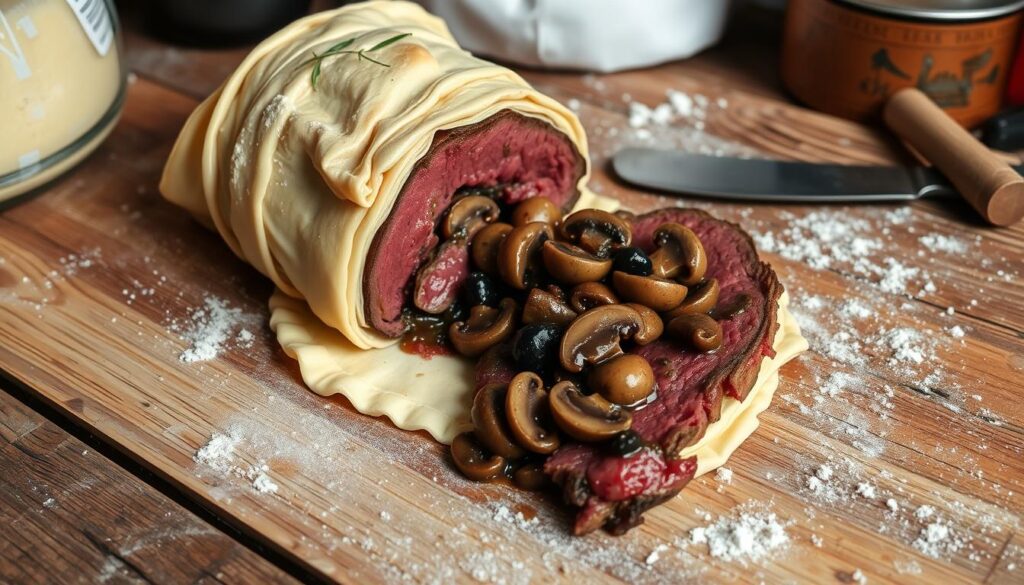
Making Beef Wellington can be hard. Many home cooks face challenges. Let’s look at common mistakes and how to avoid them for a perfect dish.
A soggy pastry crust is a big problem. Make sure your mushroom duxelles is dry and your beef is patted dry before wrapping. Also, avoid overcooking the beef. Use a meat thermometer to check the internal temperature. Aim for medium-rare at 130-135°F.
Uneven cooking can mess up your Beef Wellington. Make sure your beef tenderloin is the same thickness everywhere. If it’s not, tie it with kitchen twine before searing. This helps cook it evenly from edge to center.
Here’s a quick checklist to avoid common mistakes:
- Chill the wrapped beef before baking
- Seal pastry edges tightly
- Let the Wellington rest before slicing
- Don’t skip the egg wash for a golden crust
Remember, practice makes perfect. Even if your first try isn’t perfect, keep trying. For more baking tips, check out this guide on perfecting classic recipes.
“The secret to a great Beef Wellington is patience and precision. Take your time with each step, and you’ll be rewarded with a showstopping dish.”
By avoiding these common pitfalls, you’re on your way to a Beef Wellington that will impress. Keep these tips in mind, and your pastry-wrapped masterpiece will be the star of the show.
Serving and Presentation Tips
The perfect Beef Wellington needs a stunning presentation. We’ll show you how to make your dish look like it has a Michelin star. From slicing to garnishing, these tips will make your dish stand out.
Proper Slicing Techniques
Slicing Beef Wellington needs precision. Use a sharp, serrated knife for smooth cuts. Cut slices about 1-inch thick to show off the layers. Let it rest for 10 minutes before slicing to keep the juices in.
Garnishing Suggestions
Make your Beef Wellington look elegant with garnishes. Fresh herbs like thyme or rosemary add color and smell. A drizzle of red wine reduction sauce looks great on the plate. For luxury, try shaved truffles or edible flowers.
Recommended Side Dishes
Pair your Beef Wellington with sides that match its flavor. Here are some good options:
| Side Dish | Flavor Profile | Preparation |
|---|---|---|
| Roasted asparagus | Earthy, slightly bitter | Oven-roasted with olive oil and sea salt |
| Duchess potatoes | Creamy, buttery | Piped and baked until golden |
| Glazed carrots | Sweet, caramelized | Sautéed with honey and butter |
For dessert ideas to round out your meal, visit our Dessert & Juices Collection.
Remember, presentation is key in Michelin star restaurants. Arrange your Beef Wellington slices on warm plates. Add your chosen sides and finish with delicate garnishes. Your guests will love the taste and the look of this classic dish.
Conclusion
We’ve looked into making the perfect Beef Wellington. This dish has won hearts for many years. It’s a true masterpiece, thanks to its rich history and Gordon Ramsay’s modern twist.
Creating a great Beef Wellington is all about the details. Choose the best beef tenderloin and make a tasty mushroom duxelles. Also, make sure your pastry is perfect.
Temperature and resting time are key for a medium-rare center. This makes all the difference.
When you make Beef Wellington, add your own special touch. Try new seasonings or garnishes. With time and effort, your dish will be as good as any in a fancy restaurant. Enjoy cooking!

